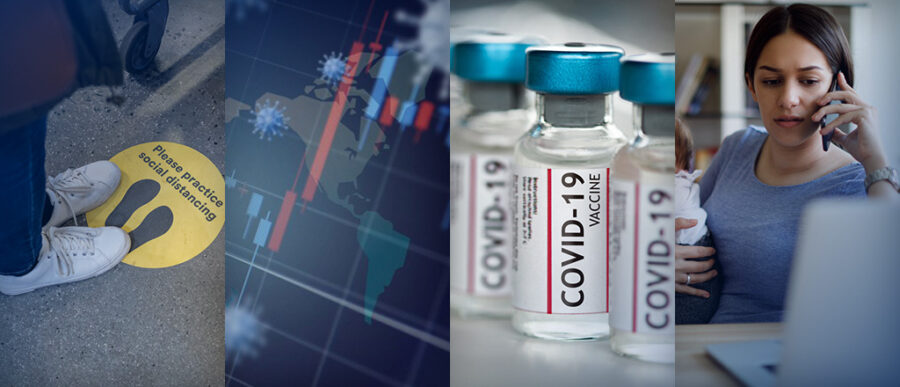When COVID-19 began its insidious march across the globe more than a year ago, it disrupted every industry and forced fast innovation as business leaders worked to adjust to a new world order. Last year, in Wharton’s Fast Forward video series, several of the School’s faculty offered their insight into what the second half of 2020 would look like during the pandemic. That insight is needed even more this year as the ground keeps shifting, vaccines are rolled out, and new coronavirus mutations emerge.
Much has changed since the start of the pandemic, from consumer behavior to health care delivery to working from home. What changes are lasting? And what lessons have we learned? We’ve asked some of our faculty to analyze what’s in store for the rest of 2021. Their responses appear below:
Will working from home become permanent for nonessential employees?
 Nancy Rothbard, Wharton management professor:
Nancy Rothbard, Wharton management professor:
I think the answer is a resounding yes. What we’ve seen throughout the pandemic is that managers have been really surprised by how incredibly well remote work has gone for so many people. This is something that, prior to the pandemic, a lot of managers viewed with suspicion. There were a lot of questions about whether people could be productive while working remotely from home, but we’ve seen people really rise to the occasion. Technology has aided this, and there have been tremendous benefits with the flexibility that we’ve been afforded by working from home.
Once we have more choice about whether we work from home or are able to go into the office, people will be able to navigate some of the challenges with remote work a lot better. For example, currently one of the really big challenges that we experience is this lack of choice and the fact that everybody else in our household is working or going to school or in the household with us. Trying to find quiet time for a meeting or have the concentration required can be hard when you’ve got a whole household around you, whose schedules may not be aligned with your own.
An important distinction when we think about remote work is the one between what I call integrators versus segmentors. Integrators are people who like to blur the boundaries between their work and non-work life; segmentors like to keep work separate. An integrator is someone like me, who might be sitting in their kitchen and taking a work call, not minding that their children or spouse might come into the kitchen to get some food. I’ve had many meetings where my children will walk behind me to the cabinet to grab a snack, and it doesn’t bother me because I don’t mind that blurring between the work and non-work life. In fact, I get a little boost of energy seeing my children during the middle of the day. It makes me happy.
Segmentors might get distracted by that and might feel uncomfortable with that. Managers really need to think about this distinction between integrators and segmentors in terms of how they’re scheduling meetings and reading cues from their employees. If you’re wondering why somebody has a blacked-out screen during a meeting, instead of assuming that they’re goofing off, you might want to not jump to that conclusion but try to empathize with the fact that maybe there’s something going on in their house that they’re worried would be distracting to the team.
I think remote work is here to stay in some form or another going forward. We’ve seen that it can be incredibly effective and that it gives us tremendous flexibility. I don’t think that we’re going to be doing remote work all the time, but some proportion of remote work is here to stay.
What’s the outlook for the stock market and the economy this year?
 Jeremy Siegel, Wharton finance professor:
Jeremy Siegel, Wharton finance professor:
Last summer, I saw a dramatic expansion of Federal Reserve liquidity, government support, and the money supply. I said then, ‘This liquidity is going to go into the stock market, and then it’s going to go into the economy once people feel comfortable with beginning their normal activities again’ — and that is exactly what is happening.
I think this year is going to be a great year for the economy, a much bigger expansion than a lot of people believe. I think it’s also going to be a year of inflation. Not dramatic inflation, but a lot more than what we have been used to — 3%, 4%, perhaps even 5%. This is going to be good for the stock market because I do not think that the Federal Reserve is going to tighten credit into 2022, maybe not into 2023. We’re going to keep low short-term interest rates and a hot economy, so inflation will begin to increase, and the stock market will be pushed ahead because corporate profits are going to be very strong.
The loser is going to be the bondholder because interest rates on the long-term bond are going to rise. We’re going to see the 10-year bond rise to 2% by the end of the year, maybe even 3% by the end of 2022.
Still, this is going to be a great year for the stock market. We might get a little over-bought in the end, and we might get a pause into 2022, particularly if inflation gets too high. But for the next 12 months, I look for a strong economy, strong stock market and rising long-term bond interest rates.
I believe we are going to see a tax increase this year — corporate taxes and personal taxes — because I think the Democratic administration under [President Joe] Biden will want to scoop up some of these extra profits that corporations are making. And they’re going to undo much, but not all, of the Trump tax cuts that we got over the last four years. If we’re going to have an infrastructure bill, that’s when I think the taxes are going to come in.
I do believe they’re going to be passing this stimulus bill. I think it is too much, given the stimulus that has been provided. But we can live with it. I think this new bill will again cause a big push on the economy, which eventually we’re going to have to pull back. But in the meantime, we can expect strong economic growth, strong equity markets, and rising long-term interest rates.
How will the pandemic continue to change the delivery of health care in the U.S.?
 Hummy Song, Wharton professor of operations, information and decisions:
Hummy Song, Wharton professor of operations, information and decisions:
For better or for worse, there have been many lessons learned regarding health care delivery over the past year. Here are four important takeaways.
Coordination is key. The pandemic has reminded us why it’s important to have an emergency preparedness strategy in place that is ready to be activated on a moment’s notice. As part of this strategy, states and regions should facilitate coordination across hospitals (which normally compete with one another for patients and revenue) to develop a centralized system that will facilitate load balancing. To help patients with COVID-19 access care, Arizona’s Department of Health Services implemented such a plan, learning from the early failures of New York. Centralized coordination can also be used to ensure continued access to non-COVID specialty care.
What’s scarce is staff. The scarcest resource when it comes to health care delivery is the staff, not PPE or beds. As cases surged across the country, health systems that were set up to keep their staffing lean pleaded with their employees to take on extra shifts and scrambled to hire travel nurses and respiratory therapists on short-term contracts. The burnout and stress, combined with exposure and infection among health care providers themselves, made staffing even more strained in hospitals. As a result, more health systems are beginning to take provider wellness more seriously, and the pool of travel nurses is growing more rapidly. Both will impact how health systems think about staffing going forward.
Embrace technologies. Telemedicine became a lifeline for many patients and providers when the initial wave of the pandemic hit. Willingly or not, it got both parties beyond the hurdle of adopting this technology. Wearable and remote-monitoring technologies are also gaining traction. Going forward, insurers and policymakers will need to work with health systems to support continued access to high-value telemedicine.
Reassess the value of health care. A silver lining of the pandemic is that it gave us an opportunity to reassess the value of health care. By measuring the consequences of altered, deferred, and missed care, researchers can help answer some challenging questions around the value of care. How often should we conduct lab tests and cancer screenings? Does the patient actually do better after that complex procedure or surgery? We have a learning opportunity before us that should not be overlooked.
What crisis management lessons will business leaders keep going forward?
 Michael Useem, Wharton management professor and director of Wharton’s Center for Leadership and Change Management:
Michael Useem, Wharton management professor and director of Wharton’s Center for Leadership and Change Management:
As we emerge from the pandemic of 2020–21, we owe ourselves and coming generations a ledger of lessons for better navigating our future calamities. From a study of how companies mastered earlier catastrophes, a colleague and I came to appreciate that there is no better management schooling than having come back from an enormous setback. I believe we are finally on our way out of this one, and now is a good time to appreciate what we should be remembering. Here is first draft of three of those management lessons.
Be there. For those responsible for others, visibility and fortitude are essential, conveying realism and optimism, mapping out what’s wrong and how we will surmount it. The chief executive of Marriott International, Arne Sorenson, posted a six-minute video message to his 175,000 employees early in the pandemic, doing just that. He had never experienced a more challenging moment, but he also affirmed that together they would persevere and ultimately prevail.
Mend. Despite plenty of red ink, the chief executive of Progressive Insurance, Tricia Griffith, opted against layoffs or even furloughs. She advanced employees a portion of their annual bonuses, expanded paid time off for those unable to work and covered co-pays for telemedicine and virus treatment. For hard-pressed customers, she reduced premiums and waived fees, all in a billion-dollar mending.
Bring the future into the present. Let’s focus on a time when we will have comeback from this setback — and then on the actions that will get us there. Several months into the pandemic, Starbucks CEO Kevin Johnson set forward “a bridge to the future,” a pathway to reopen, revise, and restore the enterprise, making for a better business from the setback.
I invite readers to share their own management lessons from the pandemic by emailing me at useem@wharton.upenn.edu. Your comments may be used in a public posting.
What changes in retail and shopping will become permanent?
 Barbara Kahn, Wharton marketing professor:
Barbara Kahn, Wharton marketing professor:
COVID-19 certainly changed shopping behavior in 2020 and continues to do so now into 2021. One survey conducted in December on 1,000 consumers showed that COVID-19 had a major impact on consumer habits, with 40% of them indicating that they had visited physical locations much less frequently since the pandemic hit. Obviously, there has been a huge acceleration to online shopping. This change in behavior not only affected where people shopped but also what they bought: 25% of the respondents said that they switch among brands more often today than ever before.
However, interestingly, 46% of the respondents said that if they had the choice, they would prefer to shop in person rather than online. That indicates that physical retail is certainly not dead, and shoppers are hungry to touch and feel the product, interact socially with sales associates and friends, and get immediate gratification in product acquisition and consumption.
But will shopping be the same when consumers return to the stores? No. Consumers had a whole year to form new habits and expectations, and those changed behaviors will not just vanish. Shopping will not become online or offline — but omni-channel. Omni-channel means a seamless integration between offline and online experiences. For the most sophisticated retailers, the omni-channel experience will be customer-focused. This means that retailers will be everywhere their customers want them to be 24/7.
Trends that started or accelerated in the pandemic, like “buy online, pick-up in the store” or appointment-based shopping, will be the norm, and physical retail will re-configure to make this more possible. We will see changes in technology development, like AR-enabled displays, frictionless payments, and BYOD (bring your own device) into the store, which puts the endless aisle and website information into the hands of the consumer. We will also see more low-touch, health-related changes to physical retail, like the addition of robots or vending machines.
We are also seeing an acceleration in live-streaming and video blogs influencing shopping behaviors. This behavior, which is very common in China, is now coming into the U.S. This contributes to the notion of “shoppertainment” and is very content driven. It focuses more on the customer experience rather than merely the acquisition of goods.
And we are seeing the convergence of online and offline in developing new retail outlets. Traditional retailers like Lululemon or Nike are becoming more digital. Nike has accelerated their direct-to-consumer marketing through their loyalty programs and apps to offer a personalized and customized experience in their stores and online. Lululemon can offer an omni-channel exercise experience to their best customers with the purchase of the Mirror. On the other hand, digitally native brands, like Warby Parker or Casper, are opening physical retail. When these brands open stores, they are usually a smaller footprint and very often showrooms rather than houses of inventory.
With all these changes to a more unified customer-centered, omni-channel experience, consumers are not losing their desire for sustainability or environmentally savvy retailing. While COVID-19 slowed down some of these initiatives (e.g., recycling, less packaging, etc.), once the constraints are lessened, we would expect to see more progress in this domain as well.
What is the future of the gig economy in the U.S.?
 Gad Allon, Wharton professor of operations, information and decisions, and director of the Jerome Fisher Program in Management and Technology:
Gad Allon, Wharton professor of operations, information and decisions, and director of the Jerome Fisher Program in Management and Technology:
I don’t think this is temporary. About 36% of U.S, workers are now involved in the gig economy, and 40% of U.S.-based workers generate a large part of their income via the gig economy. We see high unemployment levels but also more firms allowing their employees to work from home, coupled with the fact that people are leaving cities (after years of urbanization), potentially working over multiple time zones. It is quite evident that the labor market is readier than ever for more people to join the gig economy “workforce,” and we’re going to see more opportunities for these employees.
More firms will hire gig workers. Firms and startups do not need to have developers on their teams if the only goal is to build a prototype. You do not need to have a designer if you can find one on Fiverr, and you don’t need to own a car if you can use Uber to travel around town. I know that many people still own a vehicle, and many firms still employ designers. But some of that is cultural, and some of that is still the existence of frictions. McKinsey projected a few years ago that gig work will increase the U.S. GDP by $2.7 trillion. I am not going to try to defend this number. Still, it is clear that by reducing the frictions we mentioned above, the gig economy allows us, as consumers, to do things that we would not be able to do otherwise and have access to experts and service providers at a scope, speed, and cost we never had.
More gig platforms will emerge. The platforms are here to stay. They are well funded, and many of them had successful IPOs over the last few years. I see two trends in the next few years: the emergence of new platforms for more specific services, and the emergence of new platforms that support gig workers along different dimensions of their work. As more customers get used to finding service providers on these platforms and as more workers join the gig workforce, the labor market will be lubricated enough, making it effortless to launch new gig platforms that address a specific niche or more general audience.
The gig flywheel. We have to go back to the original reason firms exist. We prefer hiring someone for a full-time job, even though we need them only for a relatively short amount of time, just because of the complexity of the hiring, retaining, and managing the relationship with them. However, the complexity is being diminished and the frictions of hiring short-term workers are being reduced. In a few years, the notion of a full-time employee may be a relic of the past. As more platforms emerge, more employees join this type of work and more customers rely on these platforms, the already humming economy-level gig flywheel will only accelerate. Firms are still going to be employing generalists, but for almost everything that needs a specialist, they may rely on the gig economy.
These comments have been edited for space. Read Allon’s entire response here.


